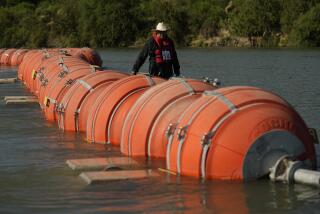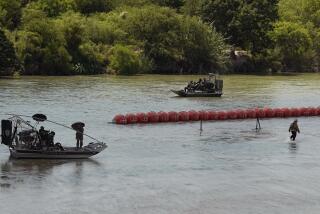Canada Sets Up Floating Border Station for Boaters
THE U.S.-CANADA BORDER ON LAKE CHAMPLAIN â The water in Lake Champlain, knowing no national boundaries, flows freely between Canada and the United States. So do hundreds of boaters, to the chagrin of customs agents.
âA border is a border, whether it is the land, the air or the lake,â said Jean Paul Barriere, who runs the Canadian port of entry.
Without a summer cruising permit, those leaving the cottage-lined beaches on Missisquoi Bay in Venice en Quebec are supposed to stop at the U.S. Customs Service house in Alburg Springs, which is all but impossible to reach by water.
It was slightly easier to get to Canadian Customs. Boaters could stop at a dock just over the border and call officials in nearby Phillipsburg.
Until this year, boaters going in and out of the bay jutting into Quebec from Vermont missed or ignored the notch in the trees that marks the line. Last year all but five âwere forgetting about reporting,â said Barriere, laughing.
To encourage respect for the border, Canada set up a floating immigration station, a 20-by-40-foot blue and orange barge officials say is a first.
On a sunny day in the middle of the week, Canadian Customs Officer Jean Pierre Fortin logged 11 boats crossing by early afternoon. He has counted more than 1,000 since he took up his post in a boat near the barge June 21.
Keeps Careful Watch
Fortin wasnât necessarily looking for drug runners or illegal aliens, although he was prepared for both. He also kept watch for people trying to escape paying Canadian taxes on boats by buying them in the United States and taking them through the bay instead of hauling them by land through customs stations.
His main reason for floating in the bay was to make an afternoon outing more pleasant by giving cruisers an easy way to report to customs. Canadian officers are on the barge between 11 a.m. and 7 p.m. until mid-September.
But for those who want to escape the bay for the open lake on the Vermont side, getting to U.S. Customs remains a trial, and sometimes a game of chicken.
Two power boats, with Canadians aboard, stopped at Fortinâs post, though technically they needed only to report at the U.S. station. One couple already had a summer permit to take their boat as far south as St. Albans Bay without a stop on each trip. But their son and a friend, in the second boat, didnât.
âAre the police down there?â the father asked. Fortin didnât tell.
Danger Ahead
The U.S. customs house is within sight, but the shallow water and rocky beach pose a greater risk than the agents; both boats whizzed past.
Fortin shrugged. He knew the boaters, and he isnât surprised they took a chance for an afternoonâs spin on the lake.
But taking the chance, and perhaps being confronted by imposing agents in uniform, is just the situation Thomas Ducharme, owner of the growing Champlain Marina and a boat dealership, wants his customers to avoid. U.S. officials are hard on Canadians, he said, and difficulty reporting has cost him customers.
When Ducharme opened his marina three years ago, he renewed a local push for a dock at the U.S. house. But the bay was too shallow and the idea grew for the floating station and Fortinâs boat, which is docked at Ducharmeâs marina.
A Pocketbook Issue
âI did it for my pocket. I want my customers to cross the border without any trouble,â Ducharme said, adding that to go by the book, he must take his customers overland to the U.S. station before sending them off for the day.
Tim Moran, assistant district director of the U.S. Customs Service in St. Albans, acknowledged âthat the honest traveler would be less apprehensive about crossing the border if they had a place to check in.â
An invitation to share the barge came too late for this year, but U.S officials want to see how it works. The crossings logged by the Canadians are more than Moran had expected, but numbers alone wonât justify a U.S. presence.
âIt would be a balancing between the numbers and the perceived threat,â he said, adding that there is âsome smuggling activity on the lake.â
More to Read
Sign up for Essential California
The most important California stories and recommendations in your inbox every morning.
You may occasionally receive promotional content from the Los Angeles Times.










